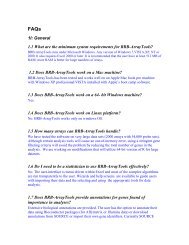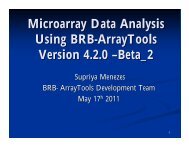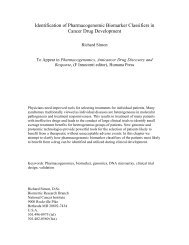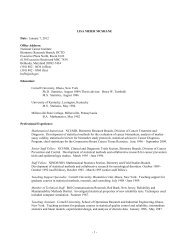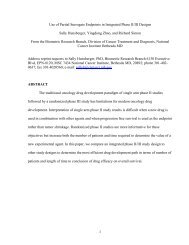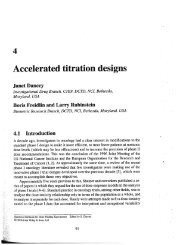A comparison of bootstrap methods and an adjusted bootstrap ...
A comparison of bootstrap methods and an adjusted bootstrap ...
A comparison of bootstrap methods and an adjusted bootstrap ...
You also want an ePaper? Increase the reach of your titles
YUMPU automatically turns print PDFs into web optimized ePapers that Google loves.
signals ( µ = 1.5 i.e. µ1= µ2in the simulation model). With these larger sample sizes(even with n=100), we find that when there are no real differences between the twoclasses, the out-<strong>of</strong>-bag estimation (OOB) <strong><strong>an</strong>d</strong> the leave-one-out cross-validation (LOOCV)still give larger variability compared to other <strong>methods</strong>; the resubstitution, the ordinary<strong>bootstrap</strong>, the <strong>bootstrap</strong> cross-validation <strong><strong>an</strong>d</strong> the .632 <strong>bootstrap</strong> still have subst<strong>an</strong>tialdownward bias (Case 1, Tables 2 <strong><strong>an</strong>d</strong> 3). When there are strong differences between theclasses, the LOOCV <strong><strong>an</strong>d</strong> OOB give smaller variability, <strong><strong>an</strong>d</strong> the resubstitution, theordinary <strong>bootstrap</strong>, the <strong>bootstrap</strong> cross-validation <strong><strong>an</strong>d</strong> the .632 <strong>bootstrap</strong> give smallerdownward bias (Case 2, Tables 2 <strong><strong>an</strong>d</strong> 3) as sample size n increases in <strong>comparison</strong> to Case2, Table 1. The .632+ <strong>bootstrap</strong> <strong><strong>an</strong>d</strong> the OOB perform better as sample size increases, butthey sometimes suffer from downward bias when n=40 <strong><strong>an</strong>d</strong> 100 (Case 2, Tables 2 <strong><strong>an</strong>d</strong> 3)<strong><strong>an</strong>d</strong> this is illustrated in Figure 3 using the results for n=40 with CART classifier.The <strong>adjusted</strong> <strong>bootstrap</strong> is robust in the sense that it remains conservative (has nodownward bias) under all circumst<strong>an</strong>ces considered in the simulation with varying signallevels, classifiers <strong><strong>an</strong>d</strong> sample sizes. It does not suffer from extremely large upward bias orvariability in <strong>comparison</strong> to other <strong>methods</strong> for small to moderate sized samples (Tables 1<strong><strong>an</strong>d</strong> 2), <strong><strong>an</strong>d</strong> it performs no worse th<strong>an</strong> the competitors such as the .632+ <strong>bootstrap</strong>, theOOB <strong><strong>an</strong>d</strong> the LOOCV for larger sample sizes (Table 3).Insert Tables 2-3 <strong><strong>an</strong>d</strong> Figure 3 about here.Additional simulations are conducted for varying signals <strong><strong>an</strong>d</strong> n/p ratios (Tables A1, A2 insupplement). We found the comparative conclusion does not depend on the n/p ratios(with n



